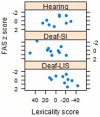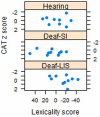Visual word recognition in deaf readers: lexicality is modulated by communication mode
- PMID: 23554976
- PMCID: PMC3595400
- DOI: 10.1371/journal.pone.0059080
Visual word recognition in deaf readers: lexicality is modulated by communication mode
Abstract
Evidence indicates that adequate phonological abilities are necessary to develop proficient reading skills and that later in life phonology also has a role in the covert visual word recognition of expert readers. Impairments of acoustic perception, such as deafness, can lead to atypical phonological representations of written words and letters, which in turn can affect reading proficiency. Here, we report an experiment in which young adults with different levels of acoustic perception (i.e., hearing and deaf individuals) and different modes of communication (i.e., hearing individuals using spoken language, deaf individuals with a preference for sign language, and deaf individuals using the oral modality with less or no competence in sign language) performed a visual lexical decision task, which consisted of categorizing real words and consonant strings. The lexicality effect was restricted to deaf signers who responded faster to real words than consonant strings, showing over-reliance on whole word lexical processing of stimuli. No effect of stimulus type was found in deaf individuals using the oral modality or in hearing individuals. Thus, mode of communication modulates the lexicality effect. This suggests that learning a sign language during development shapes visuo-motor representations of words, which are tuned to the actions used to express them (phono-articulatory movements vs. hand movements) and to associated perceptions. As these visuo-motor representations are elicited during on-line linguistic processing and can overlap with the perceptual-motor processes required to execute the task, they can potentially produce interference or facilitation effects.
Conflict of interest statement
Figures



Similar articles
-
The impact of visual cues during visual word recognition in deaf readers: An ERP study.Cognition. 2022 Jan;218:104938. doi: 10.1016/j.cognition.2021.104938. Epub 2021 Oct 19. Cognition. 2022. PMID: 34678681
-
Mapping the reading circuitry for skilled deaf readers: an fMRI study of semantic and phonological processing.Brain Lang. 2013 Aug;126(2):169-80. doi: 10.1016/j.bandl.2013.05.001. Epub 2013 Jun 5. Brain Lang. 2013. PMID: 23747332
-
The contribution of phonological knowledge, memory, and language background to reading comprehension in deaf populations.Front Psychol. 2015 Aug 25;6:1153. doi: 10.3389/fpsyg.2015.01153. eCollection 2015. Front Psychol. 2015. PMID: 26379566 Free PMC article.
-
Linguistic Skills and Text Reading Comprehension in Prelingually Deaf Readers: A Systematic Review.J Speech Lang Hear Res. 2025 Mar 5;68(3):1277-1310. doi: 10.1044/2024_JSLHR-24-00512. Epub 2025 Feb 18. J Speech Lang Hear Res. 2025. PMID: 39964401
-
Visual skills and cross-modal plasticity in deaf readers: possible implications for acquiring meaning from print.Ann N Y Acad Sci. 2008 Dec;1145:71-82. doi: 10.1196/annals.1416.013. Ann N Y Acad Sci. 2008. PMID: 19076390 Free PMC article. Review.
Cited by
-
ERP effects of masked orthographic neighbour priming in deaf readers.Lang Cogn Neurosci. 2019;34(8):1016-1026. doi: 10.1080/23273798.2019.1614201. Epub 2019 May 16. Lang Cogn Neurosci. 2019. PMID: 31595216 Free PMC article.
-
Automaticity of lexical access in deaf and hearing bilinguals: Cross-linguistic evidence from the color Stroop task across five languages.Cognition. 2021 Jul;212:104659. doi: 10.1016/j.cognition.2021.104659. Epub 2021 Mar 31. Cognition. 2021. PMID: 33798950 Free PMC article.
-
Cognition Assessment Technologies on Deaf People.J Cogn. 2023 Mar 8;6(1):18. doi: 10.5334/joc.262. eCollection 2023. J Cogn. 2023. PMID: 36910582 Free PMC article. Review.
References
-
- Goswami U (2008) The Development of Reading across Languages. Annals of the New York Academy of Sciences 1145: 1–12 doi:10.1196/annals.1416.018 - DOI - PubMed
-
- Steinbrink C, Groth K, Lachmann T, Riecker A (2012) Neural correlates of temporal auditory processing in developmental dyslexia during German vowel length discrimination: an fMRI study. Brain Lang 121: 1–11 doi:10.1016/j.bandl.2011.12.003 - DOI - PubMed
-
- Barca L, Cornelissen P, Simpson M, Urooj U, Woods W, et al. (2011) The neural basis of the right visual field advantage in reading: An MEG analysis using virtual electrodes. Brain and Language 118: 53–71. - PubMed
-
- Pammer K, Hansen PC, Kringelbach ML, Holliday I, Barnes G, et al. (2004) Visual word recognition: the first half second. Neuroimage 22: 1819–1825 doi:10.1016/j.neuroimage.2004.05.004 - DOI - PubMed
-
- Wheat KL, Cornelissen PL, Frost SJ, Hansen PC (2010) During visual word recognition, phonology is accessed within 100 ms and may be mediated by a speech production code: evidence from magnetoencephalography. J Neurosci 30: 5229–5233 doi:10.1523/JNEUROSCI.4448-09.2010 - DOI - PMC - PubMed
Publication types
MeSH terms
LinkOut - more resources
Full Text Sources
Other Literature Sources
Medical
Research Materials

